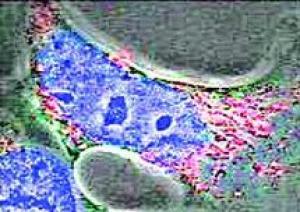
牛津大学科学家第一次发现 DNA 形成的分子笼可进入细胞内并保持完好。
牛津的物理学家和分子神经科学家的一项联合研究发现,人工用于携带药物的 DNA 笼子可以进入到活细胞中。该研究在开发新的药物递送方法方面具有潜力。
该研究的报告在线发表在《ACS Nano》杂志。
研究人员开发的这种笼子由四条短的合成 DNA 链组成。这些 DNA 链经过设计可以自然地组装成一个四面体(一个具有四个三角面的棱锥体),高度大约为 7 nm。
牛津的研究人员之前已经发现,可以在蛋白质分子周围组装这些笼子,蛋白质因此而被包在里面,并且,当在细胞中遇到特定的“触发”分子时,那种 DNA 笼子可以打开。
在新实验中,他们将荧光标记的 DNA 四面体引入到实验室培养的人类肾细胞中。然后他们在显微镜下检测了那些细胞,发现那些笼子保持完好,经受住了 48 小时分子酶的攻击。这是一个非常重要的进展:要成为可用的药物运载工具,一个 DNA 笼子必须有效进入到细胞中去,并能保持完好,直到在正确的时间、正确的位置释放它所装载的物质。
“目前我们只测试了我们创造和控制 DNA 形成的笼子,”牛津大学物理学院的 Andrew Turberfield 教授说,“但是,这些结果对于在活的细胞中使用 DNA 笼子进行传递例如药物的物质,是非常重要的一步。”
Turberfield 教授说:“由于直径小于 50 nm 的粒子相比较大粒子进入细胞的成功率更大,前期研究已经表明,粒子大小对于它们是否能轻松进入细胞至关重要。7 nm 大小的四面体对于进入细胞来说足够紧凑,大小上也正好足以携带有用物质。现在需要进行更多工作来完全弄清这些 DNA 笼子是如何找到进入活细胞的路径的。”(生物探索 william 译)
原文阅读:https://www.sciencedaily.com/releases/2011/07/110714100319.htm
ScienceDaily (Aug. 25, 2011) — Scientists at Oxford University have shown for the first time that molecular cages made from DNA can enter and survive inside living cells.
The work, a collaboration between physicists and molecular neuroscientists at Oxford, shows that artificial DNA cages that could be used to carry cargoes of drugs can enter living cells, potentially leading to new methods of drug delivery.
A report of the research is published online in the journal ACS Nano.
The cages developed by the researchers are made from four short strands of synthetic DNA. These strands are designed so that they naturally assemble themselves into a tetrahedron (a pyramid with four triangular faces) around 7 nanometres tall.
The Oxford researchers have previously shown that it is possible to assemble these cages around protein molecules, so that the protein is trapped inside, and that DNA cages can be programmed to open when they encounter specific 'trigger' molecules that are found inside cells.
In the new experiment they introduced fluorescently-labelled DNA tetrahedrons into human kidney cells grown in the laboratory. They then examined the cells under the microscope and found that the cages remained substantially intact, surviving attack by cellular enzymes, for at least 48 hours. This is a crucial advance: to be useful as a drug delivery vehicle, a DNA cage must enter cells efficiently and survive until it can release its cargo where and when it is needed.
'At the moment we are only testing our ability to create and control cages made of DNA,' said Professor Andrew Turberfield of Oxford University's Department of Physics, who led the work. 'However, these results are an important first step towards proving that DNA cages could be used to deliver cargoes, such as drugs, inside living cells.'
Professor Turberfield said: 'Previous studies have shown that the size of particles is an important factor in whether or not they can easily enter cells, with particles with a radius less than 50 nanometres proving much more successful at gaining entry than larger particles. At 7 nanometres across our DNA tetrahedrons are compact enough to easily enter cells but still large enough to carry a useful cargo. More work is now needed to understand exactly how these DNA cages manage to find their way inside living cells. '







